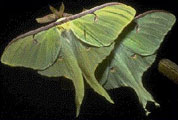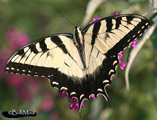Native Plants
Search for native plants by scientific name, common name or family. If you are not sure what you are looking for, try the Combination Search or our Recommended Species lists.
Betula papyrifera
Betula papyrifera Marshall
Paper Birch, Canoe Birch, White Birch
Betulaceae (Birch Family)
Synonym(s):
USDA Symbol: BEPA
USDA Native Status: L48 (N), AK (N), CAN (N), SPM (N)
A characteristic deciduous tree of the Northwoods, paper birch is a 50-75 ft. single- or multi-trunked tree with conspicuous, white, peeling bark. Loosely pyramidal in youth, the tree develops an irregular, rounded crown in maturity. Bright green leaves turn yellow in fall. One of the most beautiful native trees, with narrow, open crown of slightly drooping to nearly horizontal branches; sometimes a shrub.
Paper Birch is used for specialty products such as ice cream sticks, toothpicks, bobbins, clothespins, spools, broom handles, and toys, as well as pulpwood. Indians made their lightweight birchbark canoes by stretching the stripped bark over frames of Northern White-cedar (Thuja occidentalis), sewing it with thread from Tamarack (Larix laricina) roots, and caulking the seams with pine or Balsam Fir (Abies balsamea or A. concolor) resin. Souvenirs of birch bark should always be from a fallen log, since stripping bark from living trees leaves permanent ugly black scars.
Plant Characteristics
Duration: PerennialHabit: Tree
Leaf Retention: Deciduous
Leaf Arrangement: Alternate
Leaf Complexity: Simple
Leaf Venation: Pinnate
Breeding System: Flowers Unisexual , Monoecious
Fruit Type: Samara
Size Notes: Up to about 75 feet tall.
Leaf: Green.
Fruit: Brown.
Bloom Information
Bloom Color: Yellow , Green , BrownBloom Time: Apr
Distribution
USA: AK , CO , CT , IA , ID , IL , IN , MA , MD , ME , MI , MN , MT , NC , ND , NE , NH , NJ , NY , OH , OR , PA , RI , SD , TN , VA , VT , WA , WI , WV , WYCanada: AB , BC , MB , NB , NL , NS , NT , ON , PE , QC , SK , YT
Native Distribution: Nf. & Lab. to AK, s. to NJ, VA mts., n.e. IN, WY & n.e. OR
Native Habitat: Low, wet areas; moist hillsides; stream banks
Growing Conditions
Water Use: HighLight Requirement: Sun , Part Shade , Shade
Soil Moisture: Moist
CaCO3 Tolerance: Low
Soil Description: Moist, fertile, cool soils.
Conditions Comments: Paper birch is sensitive to disease and insects, especially the bronze birch borer, under unfavorable growing conditions. The species requires cool summers where average July temperatures are below 70 degrees. Do not prune until summer when the sap has stopped flowing. More tolerant of high pH than river birch. Short-lived. The species white bark achieves maximum ornamental value with a dark background of pine, spruce and fir. Susceptible to Bronze Birch borer and Birch Dieback.
Benefit
Use Wildlife: Songbirds, ground birds and mammals use this species.Use Other: Many First Nations in BC use birch bark as material for baskets, cradles and canoes. They drink the sap as a medicine for colds. Birch wood furnished First Nations People with snowshoe frames. The bark served as a covering for the tepee or lodge. Rolled into a spill, it served as a taper or punk-stick to keep away mosquitoes. It made good paper for kindling a fire started first in punkwood of rotten Yellow Birch. (Peattie)
Attracts: Birds , Butterflies
Larval Host: Eastern Tiger Swallowtail
Butterflies and Moths of North America (BAMONA)
|
Luna moth (Actias luna)  Larval Host |
Eastern Tiger Swallowtail (Papilio glaucus)  Larval Host |
Propagation
Description: Fall sow in moist, sandy soil with germination occuring in the spring. Germination is facilitated by exposure to light; never plant too deeply. Cuttings can be rooted but must be allowed to go through a natural dormancy period before transplanting.Seed Collection: Birch seed is collected by picking the catkins while they are still green enough to hold together. They shatter easily and should be put directly into bags.
Commercially Avail: yes
Find Seed or Plants
View propagation protocol from Native Plants Network.
National Wetland Indicator Status
| Region: | AGCP | AK | AW | CB | EMP | GP | HI | MW | NCNE | WMVE |
| Status: | FACU | FAC | FACU | FACU | FACU | FACU | FAC |
From the National Organizations Directory
According to the species list provided by Affiliate Organizations, this plant is on display at the following locations:Natural Biodiversity - Johnstown, PA
Bibliography
Bibref 1186 - Field Guide to Moths of Eastern North America (2005) Covell, C.V., Jr.Bibref 1185 - Field Guide to Western Butterflies (Peterson Field Guides) (1999) Opler, P.A. and A.B. Wright
Bibref 946 - Gardening with Prairie Plants: How to Create Beautiful Native Landscapes (2002) Wasowski, Sally
Search More Titles in Bibliography
Web Reference
Webref 38 - Flora of North America (2019) Missouri Botanical Garden, St. Louis, MO & Harvard University Herbaria, Cambridge, MA.From the Archive
Wildflower Newsletter 1994 VOL. 11, NO.1 - Winter Botanizing Using Stems, Director's Report, Welcome New Education Director...Additional resources
USDA: Find Betula papyrifera in USDA PlantsFNA: Find Betula papyrifera in the Flora of North America (if available)
Google: Search Google for Betula papyrifera
Metadata
Record Modified: 2023-03-09Research By: TWC Staff